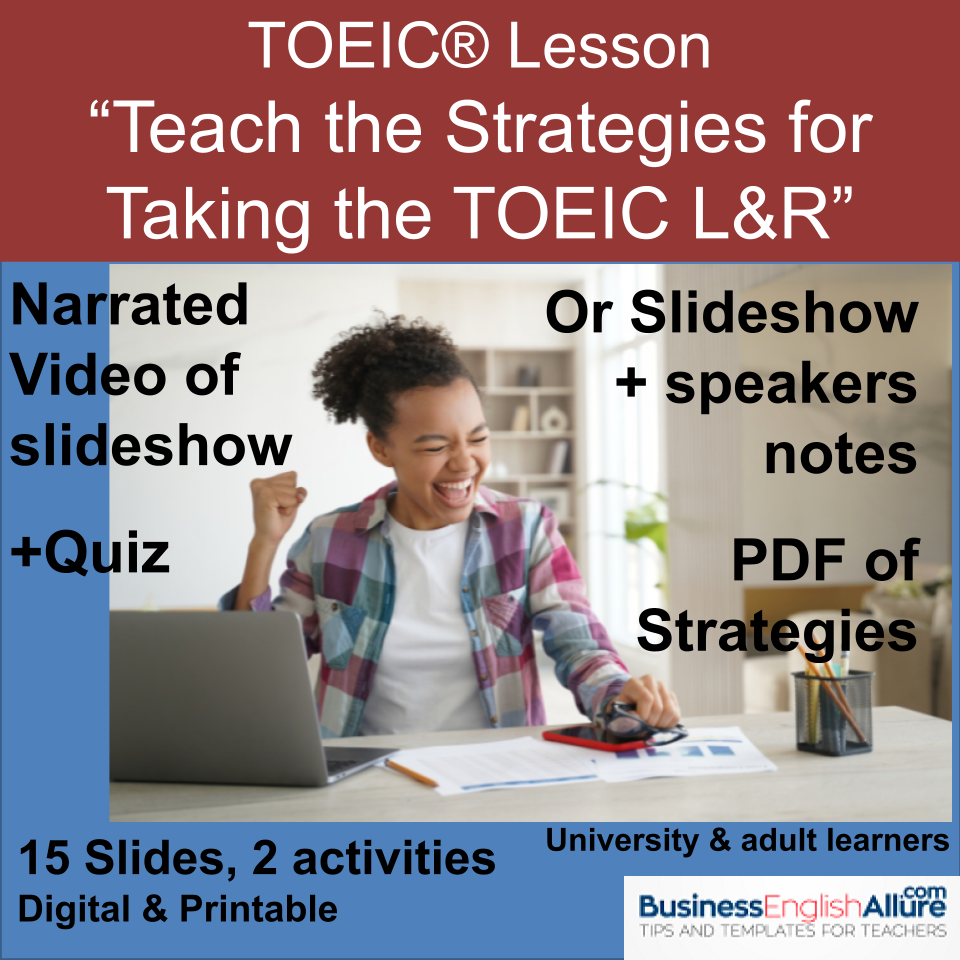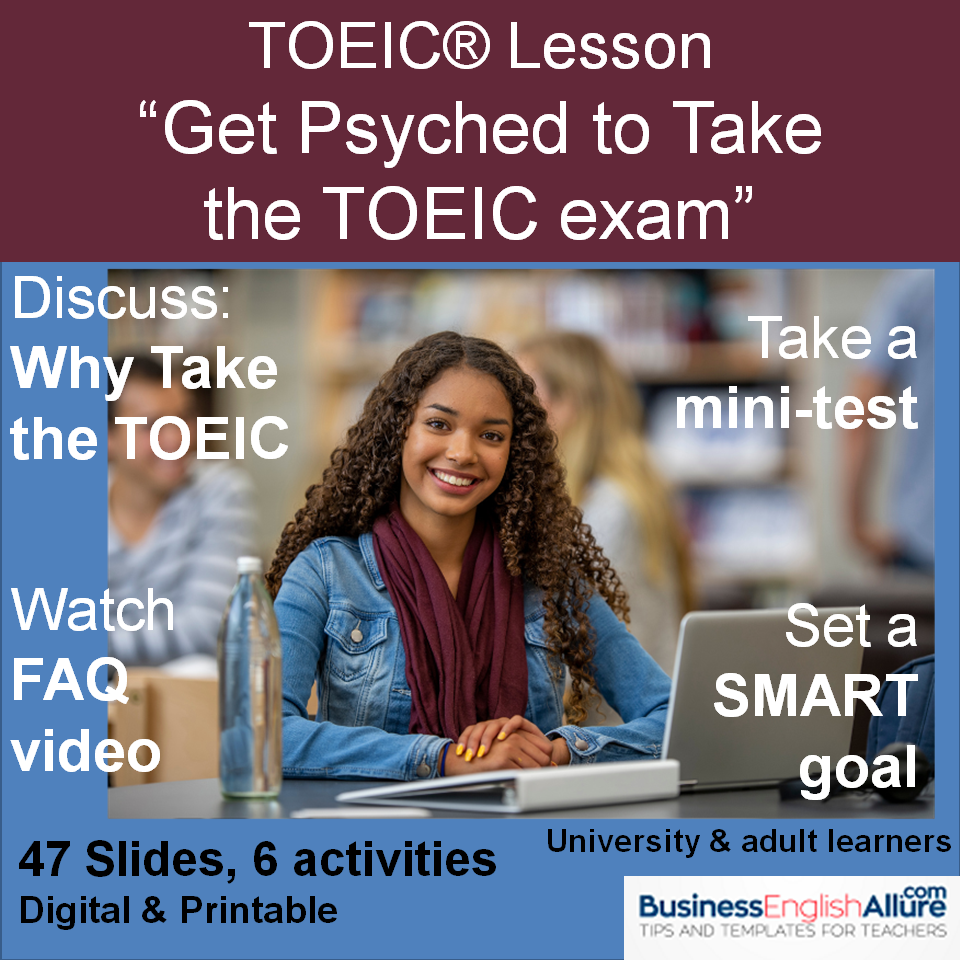Focus on Top TOEIC Topics in class

Every TOEIC teacher wrestles with choosing the content to include in a preparation course. What TOEIC topics should I cover? What are the most common vocabulary themes found in the exam? I struggled too. So I did some research and drew up a list of the most important topics.
Stick to these official TOEIC topics in your course for best results
- General Business: Conferences/trade shows, marketing/advertising, kinds of departments in a company
- Personnel: Kinds of jobs, kinds of college degrees, hiring, recruiting, job advertisements, pensions & retirement
- Entertainment: Cinema & theater, music (concerts), special events (fashion show, auctions), guided tours, libraries
- Housing & Corporate Property: Construction/remodeling, office space
- Purchasing: Shopping (retail), ordering office supplies, shipping
- Travel: Airplanes, trains, car rentals, delays/cancelations
- Technical Areas: Electronics (mobile phones, computers), technical specifications & instructions
- Dining out: Restaurants, banquets (catering)
- Finance & Budgeting: Accounting, billing, banking
- Offices: Meetings, office equipment, office procedures
Why did I create this list TOEIC topics?
I wanted to find out exactly which topics are still present on the updated test so that I wouldn’t waste my student’s precious preparation time on rare business words not commonly found on the test. And I wanted to help you make an educated guess on which vocabulary to include in your next TOEIC class.
Since each test is unique, it is almost a ‘guess’ as to what topics will be covered on test day. However, the tests are similar to one another and we can see patterns in reoccurring business topics.
I had been counting on my memory from the past to see those patterns. But those memories could be misleading. Maybe those memories were based on tests that were written by people not associated with ETS, the creators of the test.
Those ‘unofficial’ tests could stray from official business topics and older practice tests were not styled after the updated version from 2018 which includes more casual language for text messages and online chat threads. Not to mention ‘inferred meaning’ which tests knowledge of synonyms.
So over the years, I had very strong feelings about what vocabulary topics would likely be needed to be covered in my preparation courses. But that was only a feeling and not based on fact. I wanted facts.
So how did I do my research?
I just recently came across the official list of topics to study for the TOEIC which ETS publishes in its “TOEIC Test Takers handbook”. Find it on page 3 of the pdf. I saw that it was quite extensive (75 sub-topics) and I felt that some topics, from my experience, had never been covered (Labor Relations for example).

Secondly, TOEIC teachers need a more manageable list of the most important topics. So my final, pared-down list is just 33 topics compared to 75.
How did I create this list of 33 TOEIC vocabulary topics?
Step 1: I started with the long official list of subjects from ETS as my base.
Step 2: I then decided to scrutinize an official updated practice test so there would be no more guessing. I chose the best practice test I could find: Test N°1 from the book “Les Tests TOEIC Officiels Corrigés” from Hachette publishing here in France. One that is authorized by ETS the creators of the TOEIC Listening & Reading exam and up-to-date version from 2018 that includes the new less-formal language of text messaging and chat threads.

Step 3: I pored over Practice Test N°1 and jotted down 507 words and expressions form it that I considered useful to learn for a B1 level test taker. I pulled out words from all seven parts of the test, the listening and reading sections, and I surprisingly found a ton of vocabulary in the answer choices.
I then categorized each word or expression according to the list of official TOEIC topics and made a table. That was not an easy task because some expressions could be used in any number of topics. So I categorized these general English words and expressions under the topic of the text, dialogue or short talk they were found in. You can download the full list of words and expressions here.

Step 4: Next, I made an Excel spreadsheet listing the 75 sub-topics alongside their main topic. I counted the number of vocabulary words I found for each of the 75 topics. That’s what you see in N°4 above. It’s in alphabetical order by main topic. You can download a pdf of this list here if you think it might be useful.
All TOEIC topics are not equal
Step 5: I used Excel to sort my list of sub-topics from the greatest number of words down to the least. By doing so I was able to rank the top 33 sub-topics! Can you see N°1 is shopping?

After all this work I still had doubts. I questioned if I should base my recommendations solely on counting and categorizing words? Wouldn’t the number of documents for each topic be a better quantifier of the most important topics in a TOEIC test?
Document & subjects for each part
Step 6: I made a list of all the dialogues, short talks and documents in the Practice Test N°1 with a description of each and their sub-topic. I found 38 documents including four documents discussing retail shopping! Download that pdf here to give you an idea of what kind of documents to use in your course.

Step 7: As I said earlier, even though each test is unique similarities and patterns can be found. When writing my last blog post on “TOEIC Experts Agree: Vocabulary is Vital” I came across a free coupon to take the ETS TOEIC training program. Since it was a limited time offer, I took extensive notes on the content which included a list of the titles of all 30 documents, dialogues, and short talks. So I compared the content of the ETS training program to the documents in the Practice test N°1 and found the patterns and similarities I had expected.
So now I could make sure that all my top 30 topics were covered in one or more documents from the Practice Test N°1 or the TOEIC training. I only had to make one or two adjustments. Now, I felt confident to publish my recommended list.
Why trust my list?
It would be great if ETS would publish some statistics, but they don’t even supply a word sheet. I know that every test is “unique” and that these results based on one practice test are not hard evidence. But I figure my findings are useful and could help other TOEIC trainers to put together a course of listening and reading materials likely, but not certain, encountered on test day.
Finding the right material for your course
TIP N°1: You’re not creating a test, just a preparation course. So use the list of documents in Steps 6 & 7 as a guide. You don’t need to match the document and the subject exactly. Just find the vocabulary topic in anything: video, article, exercises. Then make your vocabulary games from that or make your flashcards. (See more later about a vocabulary game template).
Students will need to be familiar with all formats: email, text messaging threads, chat rooms, memos, faxes or letters, invoices. But just familiar enough to recognize the sender, receiver, date, invoice number.etc. Don’t be fixated on finding an email for a contract. That would be a waste of time.
TIP N°2: Don’t go too deep into the vocabulary. Always keep in mind the exam covers workplace contexts. For example contract law is too deep. We will probably only see an email between a business and its client with vocabulary such as ‘sign an agreement’, ‘make a deal’, ‘signup a new account’, ‘renew a contract’. Stick to common collocations.
Use the website Linguée.com to find ideas for sentences and texts. Just type in your TOEIC topics. (See below for a more detailed explanation of using Lynguee.)
Where to look for TOEIC course content.
Google Search: Type your sub-topic into the Google search bar and be sure to include ESL vocabulary. This will limit the results to content designed for English learners and not native speakers. A script of a video could be turned into a gap-filling exercise or game. Don’t forget to scroll down and view the images for vocabulary worksheets that could be easily cut up to make flashcards. Any search results from Pinterest.com will have useful images as well.

Lynguee.com: This is a website that has compiled a huge database of texts and articles that have been officially translated. You choose your preferred languages (mine is English-French) and type in a vocabulary word or expression. Scroll down through the dictionary section to the “External Resources”. You’ll see two columns of extracts from documents that have been translated with your search word highlighted.
I love this website for finding sentences with a business context to use in quizzes for example. Just copy and paste. You can also click on the extract to view the whole article. See the sentences I came up with for the category “Dining Out” and the word “waiter”?

ESL Resources: This website is difficult to navigate but is jam-packed with links to all kinds of sites. Scroll down to related topics to continue searching. There’s really no home page since each topic is the collection of a single teacher. So to change topics just go back to Google search and type in a new topic with “ESL Resources”. I loved the variety of documents: news articles, cartoons, jokes, dialogues, and podcasts. Really rich source of TOEIC content.

BreakingNewsEnglish.com: This is a website that takes current event articles and rewrites them at different levels for ESL learners. Here’s his category Business English Lessons that has many news articles appropriate for a TOEIC course. Lots of exercises for each article. Choose level 5 or 6 for B1 or B2 levels.

How to make a vocabulary game with your text and my template
Match definitions or synonyms to the boldfaced vocabulary in a vocabulary-rich text of your choice. Find short texts on Top 10 TOEIC topics using the search ideas above. Select up to 12 words to learn. Write short definitions for each. Students try to grasp meaning from the new word used in a sentence from the text. Then they scan through the definitions looking to match the new word to the definition.

Download the Blank Word template here.
This is a phrasal verb game where students insert a preposition into a verb phrase. This is a good group activity. The gap-filling flashcards provide a quick review of the 12 phrasal verbs. Time the students going through the flashcards. Fastest time wins. Just [click on the text boxes] then type your content into the template.

Download the blank Word template here.
Learn how to make your own game templates in MS Word
Watch this video on how to create template fields in an existing Word document, just like I did. This video was made for WORD 2007, but I read in the comments that the template fields work in later versions of Word too including Word 2010 and 2013.
Let me know in the comments below what you think of my Top 10 list of topics. Would you delete some and add others? And tell me how you did at using the game templates. I know that navigating tables in MS Word takes some getting used to.
Related Blog Post
Here’s an article of mine on the importance of reviewing vocabulary on any topic in a timely manner. It suggests creating a simple vocabulary game to do after the lesson as a first review. /game-reviewing-english-vocabulary/











